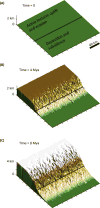Biodiversity and Topographic Complexity: Modern and Geohistorical Perspectives
- PMID: 28196688
- PMCID: PMC5895180
- DOI: 10.1016/j.tree.2016.12.010
Biodiversity and Topographic Complexity: Modern and Geohistorical Perspectives
Abstract
Topographically complex regions on land and in the oceans feature hotspots of biodiversity that reflect geological influences on ecological and evolutionary processes. Over geologic time, topographic diversity gradients wax and wane over millions of years, tracking tectonic or climatic history. Topographic diversity gradients from the present day and the past can result from the generation of species by vicariance or from the accumulation of species from dispersal into a region with strong environmental gradients. Biological and geological approaches must be integrated to test alternative models of diversification along topographic gradients. Reciprocal illumination among phylogenetic, phylogeographic, ecological, paleontological, tectonic, and climatic perspectives is an emerging frontier of biogeographic research.
Copyright © 2017 Elsevier Ltd. All rights reserved.
Figures






References
-
- Kiessling W, et al. Reefs as cradles of evolution and sources of biodiversity in the Phanerozoic. Science. 2010;327:196–198. - PubMed
-
- Mittelbach GG, et al. Evolution and the latitudinal diversity gradient: speciation, extinction and biogeography. Ecol Lett. 2007;10:315–331. - PubMed
-
- Jablonski D, et al. New perspectives from a synthesis of paleobiology and biogeography. Am Nat. 2017;189:1–12. - PubMed
-
- Badgley C. Tectonics, topography, and mammalian diversity. Ecography. 2010;33:220–231.
-
- Bellwood DR, Meyer CP. Searching for heat in a marine biodiversity hotspot. J Biogeogr. 2009;36:569–576.
Publication types
MeSH terms
Grants and funding
LinkOut - more resources
Full Text Sources
Other Literature Sources
Miscellaneous

